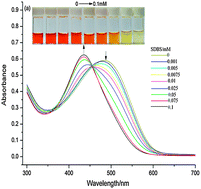A novel cationic polythiophene derivative, poly[N,N,N-trimethyl-4-(thiophen-3-ylmethylene)cyclohexanaminium chloride] (PTCA-Cl), has been prepared successfully and applied as a colorimetric and fluorometric probe for the detection of anionic surfactants. In particular, a new method for the polymerization of cationic polythiophene derivatives is found, which has not been reported previously. The colorimetric and fluorescent response of PTCA-Cl to anionic surfactants have been investigated by absorption and emission spectroscopy. The sensing interaction can be apparently observed by the naked eye, which presents a great advantage for its practical applications. Moreover, the sensor (PTCA-Cl) shows high selectivity towards anionic surfactants in the presence of other negatively charged analytes, as well as high sensitivity with a detection limit at 10−9 M by using fluorimetry, which is the lowest ever achieved among all synthetic anionic surfactants sensors available. Therefore, the water soluble polythiophene derivative can be applied as a colorimetric and fluorescent probe for the detection of anionic surfactants with high selectivity and sensitivity.

You have access to this article
 Please wait while we load your content...
Something went wrong. Try again?
Please wait while we load your content...
Something went wrong. Try again?


 Please wait while we load your content...
Please wait while we load your content...